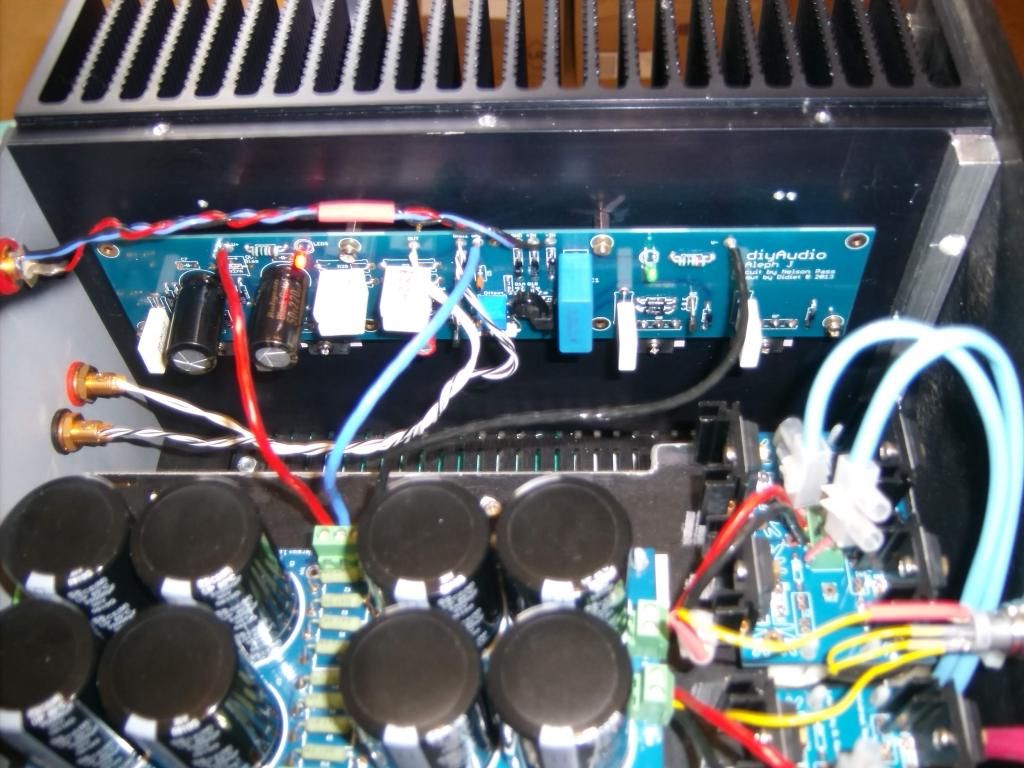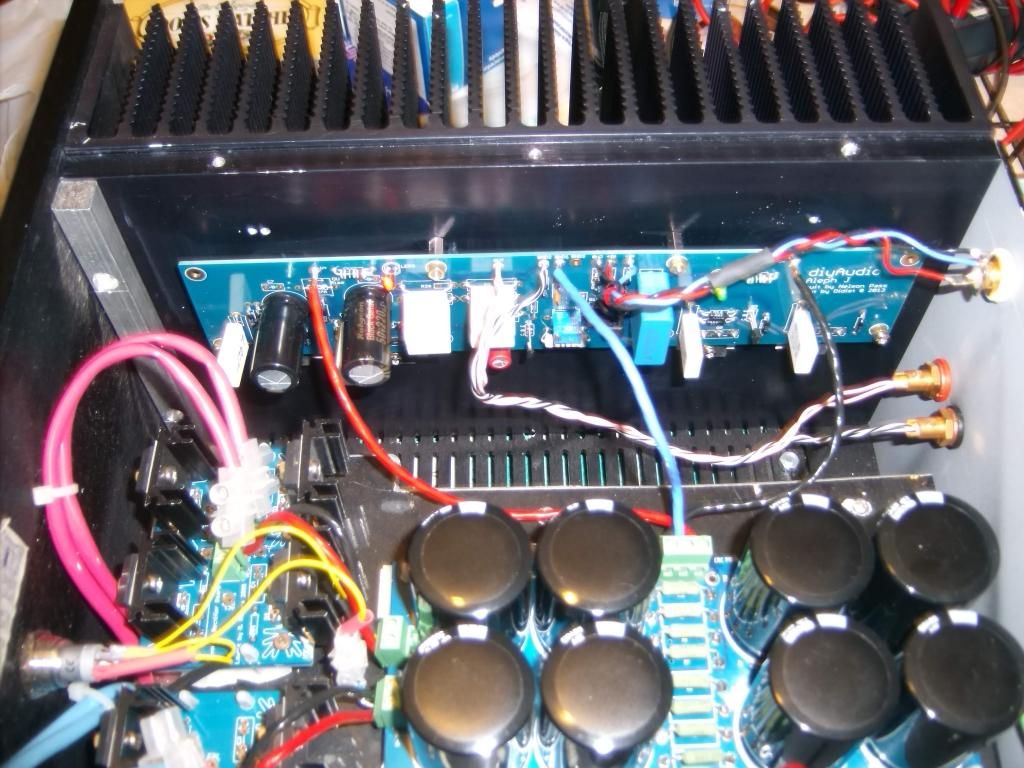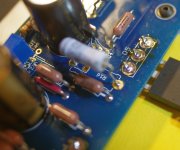isnt the non dale in the wrong hole in the pcb? shouldnt it be up one more to close the cir?
looks to me like its soldered to itself so to speak. or am i wrong? id have to look at my boards.
That's the best idea so far! Am I so stupid so didn't watch the layout?! Will go and check 🙂
dont get too excited! its me after all dodo of all dodo's
Yep! That was it! Gain, I have gain! Thank you, I would newer find it! 🙂
Last post for tonight: I really think this is one of the best amps ever... Maybe even my favorite (maybe) 🙂.
Another thing for future builders: if everything done properly this amp is super quiet. I can't hear any hum with my ear right next to my ~89db speakers.
Another thing for future builders: if everything done properly this amp is super quiet. I can't hear any hum with my ear right next to my ~89db speakers.
isnt the non dale in the wrong hole in the pcb? shouldnt it be up one more to close the cir?.
Good catch!!! 😎😎😎
I was so caught up in reading the value that I didn't even see the placement error!😱
Good catch!!! 😎😎😎
I was so caught up in reading the value that I didn't even see the placement error!😱
not a catch if ive done it too. haha
PKI, just caught the stupid comment.
not a stupid mistake unless you do it again. 1st one you call experence,after that well......... up to you, if u tell anyone. ;-)
Jean - For heatsink size, the 4U chassis from the store should be considered the absolute minimum. These amps do get hot. 🙂
Wengtech - A 20+20V transformer will be fine. It's going to run a bit hotter, but you can always turn down the bias a bit if needed.
Your soldering looks fine... although you are missing some transistors... 🙂 🙂 🙂
Seems like a huge chassis for Aleph J, I am all for overkill but I am trying to understand why you say 4U is minimum?
According to Nelson, these dissipate about 60 watts per channel and should be happy with 25 deg C rise above ambient, or 0.4deg/watt or less per channel for heatsink.
What is the rating of the 4U case in terms of C rise?
A few pics of my single supply build.Top;bottom & front panels are from Modushop with heatsinks from these guys in the UK
http://www.gdrectifiers.co.uk/uploads/010118.pdf
AndrewT will no doubt tell me to twist the wires.
Nice job! So it's 300mm depth, what is the height of the heatsinks you used?
turning up the VAC
OK, back home I ventured to test higher AC on the primary...
Somewhere around 52VAC in, the VDC across R18 starts to read above .4 I got briefly to 60VAC in with a reading of .550VDC across R18
The DC offset dropped down to almost zero
Should I be doing this testing with the input RCAs shorted out? Should I have a load across the speaker terminals?
OK, back home I ventured to test higher AC on the primary...
Somewhere around 52VAC in, the VDC across R18 starts to read above .4 I got briefly to 60VAC in with a reading of .550VDC across R18
The DC offset dropped down to almost zero
Should I be doing this testing with the input RCAs shorted out? Should I have a load across the speaker terminals?

No load on speaker.
Inputs open or shorted is fine, shorted is probably a bit better.
Turn down your R27 pot a 3-4 turns and see if the bias amount reaches 0.4v at a higher AC input.
Inputs open or shorted is fine, shorted is probably a bit better.
Turn down your R27 pot a 3-4 turns and see if the bias amount reaches 0.4v at a higher AC input.
Hello 6L6,
I turned down R27 to 40K and it only changed the point (where the voltage across R18 got to .4V) by 1V.
This brings me to a question I had in building the Aleph J - the use of jumpers. I had the impression on had to use both the R27 Jumper and the pot for R27. Is this my issue, that I have used both?
I turned down R27 to 40K and it only changed the point (where the voltage across R18 got to .4V) by 1V.
This brings me to a question I had in building the Aleph J - the use of jumpers. I had the impression on had to use both the R27 Jumper and the pot for R27. Is this my issue, that I have used both?
Attachments
when testing/setting - no load , all inputs grounded
regarding other question - I'm not familiar with particular pcb , so others will chime in
regarding other question - I'm not familiar with particular pcb , so others will chime in
I had the impression on had to use both the R27 Jumper and the pot for R27. Is this my issue, that I have used both?
Jumper and pot is correct. If you were missing the jumper you would have no control over the Aleph CCS and it would be set to max, and therefore max bias.
OK, so the jumper is correct and I should have control over the CCS but it seems like the dern thing is running wide open.
Any ideas?
Any ideas?
Well guys, I just turned R27 all the way down and got the bias to behave.
Coming back up to about 15K or 22% of the design spec got the required .4V across R18 which held pretty steady for a half hour 😱
Thanks for holding my hand while I exited my safety zone.
I'll never know why I'm so far off from build specification. I guess there are too many variables at play.
One happy spec it the heat sinks work pretty well stabilizing at 95 degrees Fahrenheit (35C or 17C above room temp). I gather this means I could run my amp a little hotter on the bias, perhaps .45V across R18?

Coming back up to about 15K or 22% of the design spec got the required .4V across R18 which held pretty steady for a half hour 😱
Thanks for holding my hand while I exited my safety zone.
I'll never know why I'm so far off from build specification. I guess there are too many variables at play.
One happy spec it the heat sinks work pretty well stabilizing at 95 degrees Fahrenheit (35C or 17C above room temp). I gather this means I could run my amp a little hotter on the bias, perhaps .45V across R18?

I'll never know why I'm so far off from build specification. I guess there are too many variables at play.
Because unlike Papa, you don't have tens of thousands of Fets to choose from, and get the exact sweet spot in the circuit. 😉😉😉
This is the exact reason why there are so many pots on the PCB - most people are going to have Jfets of a slightly different Idss and Mosfets of a slightly different Vgs than whatever is 'perfect'.
Regardless, it's going to sound fantastic.
😀 😀 😀
- Home
- Amplifiers
- Pass Labs
- Aleph J illustrated build guide





